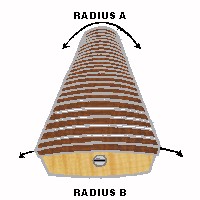
The fretboard
radius is measured by taking a slice of a certain diameter circle. The
smaller the circle radius, the more curved the fingerboard will be. Old
Fender guitars featured a small fingerboard radius (7-1/2") and a narrow
neck. For this reason, these necks are more comfortable for some
people, especially those with small hands.
Enter Warmoth, who popularized the compound radius neck. To
further facilitate string bending, they created a neck which gradually
changes from a 10" radius at the nut (radius A below) to a 16" radius where
it joins the body (radius B below).

Many manufacturers have adopted this approach, especially in custom
made models. But where does this leave the player who favors the
old Strat neck? The answer: with high action. I personally
like the feel of old Strat necks but prefer the strings fairly close to
the frets. My solution: I removed the frets on a Strat-style
guitar, compounded the radius from 7.5" (radius A above) to 10" (radius
B above). I then refretted the neck with medium frets. DO NOT
TRY THIS AT HOME unless you have some experience. I now have a neck
which maintains a vintage feel while allowing lower action and better string
bending. I wish someone would put this neck into production; it has
a great feel but it took a lot of delicate work to compound the radius
by hand.
Another significant property of guitar necks is the thickness and shape of the back of the neck. This can be the most important factor in just how comfortable the neck feels to you. Probably the most common neck shape is the "C" shape. The examples shown are how the profile of the neck would look if you sawed it in half at the 5th fret:
"C" SHAPE  "V" SHAPE
"V" SHAPE 
"D" SHAPE  "U" SHAPE
"U" SHAPE 